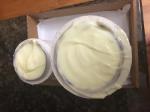Soap Separated
by Cal
(UK)
This is first soap attempt, used the following recipe
The five main ingredients are 900ml water, 295g caustic soda, 615g coconut oil (or vegetable fat), 800ml sunflower oil, 800ml olive oil.
The soap did reach the thickening/creamy stage but on putting into a mould and leaving for 24 hours, it separated out with a layer of oil on the top.
Help new to soap making what can I do?.
I've already poured oil off one mould. Should I reheat/throw away or will the stuff underneath be ok to use after 6 weeks.
Answer:
Hi Cal,
First off...I wouldn't use that recipe again and I'll tell you why.
1. The recipe uses millilitres for the water and some of the oil measurements. You really need to use weight measures when creating a soap base recipe.
It's okay to use volume for scent, colour and other additives but stick with weight with water, lye and base oils.
2. The recipe instructs you to use coconut oil (or vegetable fat). This is a very risky thing to do.
It assumes that the vegetable fat you are going to substitute has the same saponification value as coconut oil and this will not be the case.
You cannot simply substitute one oil for another without recalculating a recipe. Also, coconut oil performs a specific function in a soap recipe.
There are only two other oils that will perform the same way...Babassu oil and palm kernel oil. You can still make a soap without these oils but the same bubbling action will not be present in the final bar.
As to why your soap seperated....there are a couple of reasons why this may have happened.
1. The recipe could have inaccurate amounts of sodium hydroxide for the amount of oils used.
2. Insufficient stirring. Sometimes when mixing the oils to a trace we reach what is called a 'false trace'. This can often happen when mixing with a stick blender.
Everything looks good and thick but with a little hand stirring, the mixture becomes more liquid again.
The proper way to use a stick blender is to give it a burst of power for about 3 to 5 seconds and hand stir. Alternate repeatedly until the soap has reached trace. Be sure to hand stir for a minute or so before pouring the soap into the mold just to be sure it is a true trace.
You've asked what to do with the soap you have made already.
One option is to throw it out and start over.
The other option is to gather up the seperated oils, chop up the soap and place it all in a slow cooker (crock pot). Use the crock pot rebatch method shown here.
Once the soap has rehardened, I would check to see if it is caustic or not. Do the 'zap test'...touch your tongue to the soap and if you get a 'zap' then the soap is not good for skin care use.
If you do get a zap, do not despair...you can grate it up for use as laundry soap.
For your next batch of soap, try using one of the many recipes on this site posted here and here. The measurements are all listed in ounces, grams and by percentages for your convenience.
Don't forget to read up on fats and oils, lye and the different processes used in soap making.
Good luck and have fun,
Cathy
Comments for Soap Separated
|
||
|
||
|
||
|
||
|
||

